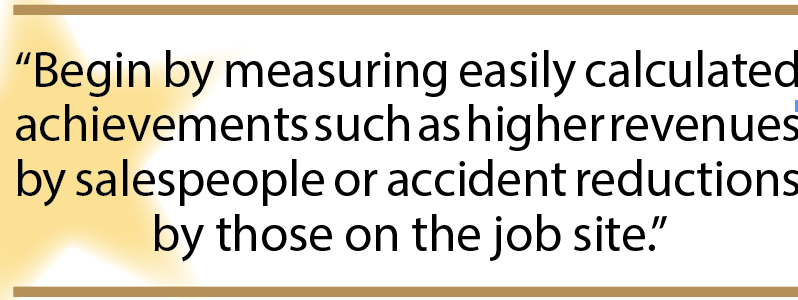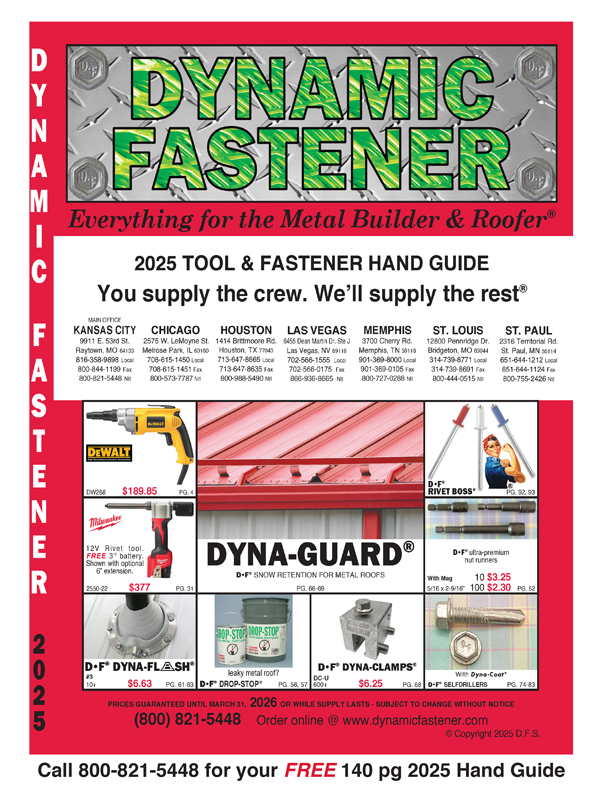By Phillip M. Perry
It’s a nightmare scenario for any business: A star employee suddenly decides to jump ship for the competition. Out the door goes years of experience, in-depth knowledge of the company’s plans, and probably a good number of hard-won customer connections.
It’s that last part, with its costly ramifications, that can cause the most immediate damage. “Customers will often follow a departing employee out the door to his or her new employer,” said Richard Avdoian, an employee development consultant in Metropolitan St. Louis. (www.midwestbusinessinstitute.com). “People like to stay with employees they trust.”
Longer range, the ghosting of a top-performing employee obviates any plans for grooming that person for a foreman or management role. “When you lose your best employees, you lose not only their skills but also their leadership potential,” said David Dye, President of Let’s Grow Leaders, a management consulting firm in Washington, D.C. (www.lets growleaders.com). In rural areas especially, where employers reside far from large cities with concentrated pools of talent, quality workers come at a premium.
Spot the Stars
How about your own business? Do you think your top performers will hesitate to leave? Maybe so, but the fact remains that people who perform the best in the workplace tend to suffer the most from wandering eyes. A survey by SAP and Oxford Economics, published in The Harvard Business Review (HBR) (“What High Performers Want at Work” by Karie Willyerd) found less than half of high performers satisfied with their current duties. One in five is likely to seek a greener pasture in the next six months. “Top performers are often less than content with their jobs,” said Avdoian. “Many want to further their careers by moving on to more promising positions.”
You can take steps to keep your own best people from jumping ship. Begin by making sure you focus on the brightest stars. Avdoian suggested looking at your employment pool as a complex of three classes of workers on an escalating scale of value: slackers, foundationals, and high achievers. Slackers are easy to spot—they do the bare minimum to collect their paychecks. Foundational employees, in contrast, perform their duties in a conscientious and dependable manner, serving as reliable anchors to your business. The final category consists of people who outperform the norm. “High achievers are driven go-getters,” said Avdoian. “They are your most productive employees.” These individuals can deliver up to 400% more productivity to a job than other employees, according to the HBR report.
With this short list in hand, make sure you give your best people the specific things they need to keep them on board. And just what do they want more than anything else? The answer is probably not surprising: The HBR report found that top performers care significantly more than average or low-performing ones about competitive compensation. You must offer them a wage commensurate with their skills and at least equal to what other employers in your region provide.
Pay for performance
High performers also care more than their slacker or foundational coworkers about the ability to earn bonus pay based on performance. “The opportunity to make more money through their achievements is an incentive for your top performers to stick around,” said Donna Cutting, CEO of Red Carpet Learning Systems, Asheville, North Carolina. Top salespeople, for example, will expect additional compensation when they outperform their peers. The goal is to create a win-win situation for employer and worker: Fixed compensation costs remain low while employees have the chance to earn more when they excel.
A pay-for-performance system is a far cry from old familiar reward relics of the past, such as the annual seniority-based wage hike and the automatic year-end bonus. The problem was that the conventional system wasn’t getting the job done, basically because it did not incentivize better performance. Moreover, high performers resented the fact they were not rewarded for their superior productivity at a rate any higher than others. Meanwhile, ongoing increases bloated payrolls until the business risked becoming uncompetitive.
Besides its direct financial component, such pay serves to highlight the connection between employee actions and organizational success. “It’s important that people understand their overall part in the success of a business,” said Cutting. “Performance-based pay does that.” At some companies, performance compensation represents 20% or more of take-home pay.
Valuable as it is as a retention tool, performance-based pay carries the hazard of unwittingly rewarding the wrong behavior. “You need to be careful that the performance objectives you set are in alignment with your business values,” warned Cutting. She points to the recent experience at Wells Fargo, a bank that rewarded its employees for burdening customers with unwanted accounts, as a textbook illustration of a performance-based pay scheme gone bad. “You have to make sure the objectives you set are not just based on sales or revenue, but also on the way customers and colleagues are treated.”
The salesperson who is making a great number of sales may also have a rushed, impatient manner that irritates your customers. Gear your bonus plan to reward employees for quality service. Use the telephone, a mailed survey, or the internet to assess customer satisfaction.

On the other side of that coin, performance-based pay won’t work if employees are unclear about how their actions directly contribute to the company’s bottom line, or lack sufficient know-how to perform to their maximum potential. “You need to make sure employees have a sufficient measure of control over meeting the described objectives,” said Cutting. “And they must be given the proper tools to do so.”
Include Everyone
One more hazard for performance-based pay: Employees left out of the program may resent their inability to earn bonus compensation. That’s why it’s important to include everyone, even those for whom it’s difficult to measure quantifiable workplace results.
“For people who are solely responsible for their work, and where their activities can be readily quantified, pay-for-performance plans are more straightforward,” said Dye. That’s why many organizations begin by measuring easily calculated achievements such as higher revenues by salespeople, accident reductions by those on the job site, and glowing reports for customer service representatives.
Designing an effective program is more difficult for some members of the support staff who do not perform in quantifiable ways. However, it is not impossible. “You can make pay-for-performance work for receptionists, maintenance, or any kind of support staff, as long as they are given the necessary tools by management,” said Cutting.
The biggest challenge is finding a way to measure support staff performance that is fair and reasonable. One approach is to ask, “What is this person’s job and how well are they doing it?” Perhaps a receptionist answers the phone before three rings or greets customers in a cheerful and professional way. If you ask employees how they measure their own performance, you may hear good ideas that can be translated into a quantifiable system.
Assure success by continually expanding your plan’s scope. Include more people and develop more refined performance assessment parameters while soliciting feedback from participants.
A Healthy Environment
Vital as it is, performance pay is not the only tool for retaining top employees. You also need to cultivate a respectful and supportive work environment. “It’s important that people understand what the business wants, and that they feel valued when they meet the employer’s expectations,” said Cutting. “The ability to contribute and to feel involved with the success of the company can be its own motivation.”
Here are some additional factors that may keep your best people aboard:
Autonomy:
“High performers do not like to be micromanaged,” said Christina Eanes, a workforce management consultant in Alexandria, Virginia. “They want the freedom to do their job in a creative way, along with the requisite responsibility and authority.” That serves the organization well. “Innovation happens when smart people find new and better ways to get their jobs done.”
Frequent feedback:
Top performers want to know where they stand, and want feedback more than once a year. A negative December surprise, especially if it affects their expected bonus pay, may well send them packing. The HBR report highlights the importance of monthly performance reviews.

Advancement pathways:
Top performers expect the employer to help them advance in their fields. “You need to create a culture where people want to work with you because of what they are going to learn and have a real clear-cut career ladder so they see how they can move up,” said Cutting.
Sometimes clearing a path for advancement is easier said than done. In a perfect world, a business would have enough open management positions to accommodate every deserving person. Reality is often much different. What can you do? “You need to create a growth path for top-performing people that keeps them feeling challenged even though they are not advanced into management positions,” said Dye.
One solution is to feed the craving of top performers for new skills. “High achievers have an insatiable need for self-development,” said Eanes. “They have an ingrained need to develop themselves, so the more opportunities you can provide them to learn, the more loyal they will be.”
Those opportunities can be offered by thinking laterally. “Not every top performer expects that advancement means a higher-level position,” said Eanes. “Millennials, especially, often prefer to move laterally because it provides them with more learning opportunities and more challenges.” A high-performing individual in sales, for example, might welcome a move to an adjacent position in human resources with the chance to learn a new set of marketable skills.
Tailor Your Offer
Because not all top performers have the same motivations, you need to consult with each of them to better understand specific needs. “I suggest designing what I call an Individual Development Plan (IDP) with each person,” said Eanes. “Determine the next logical level of knowledge and expertise and what can you do to help them achieve it.”
An IDP might include a planned pathway to advancement, or the acquisition of new skills. One individual might take on responsibility for larger projects. A second might share their knowledge by training other people. A third might cross-train in areas outside of their core competency. Think of these as “expertise promotions.”
These work environment modifications, combined with a robust pay-for-performance plan, should go a long way toward keeping your best people from jumping ship. Monitor how well you are doing by asking your staff for feedback. And observe how employees perform: Are they acting in more motivated ways and paying closer attention to things that are really important?
Creating a program to retain your top people takes time and effort. The payoff, though, can be considerable, and letting things slide is unacceptable. “Businesses which fail to retain their best people will be stuck with a majority of their employees being slackers and overtaxing the foundational employees whom they rely on for productivity,” said Avdoian. “And that will lead to a decline in employee morale, which will in turn impact productivity and devastate profitability.” MR






















